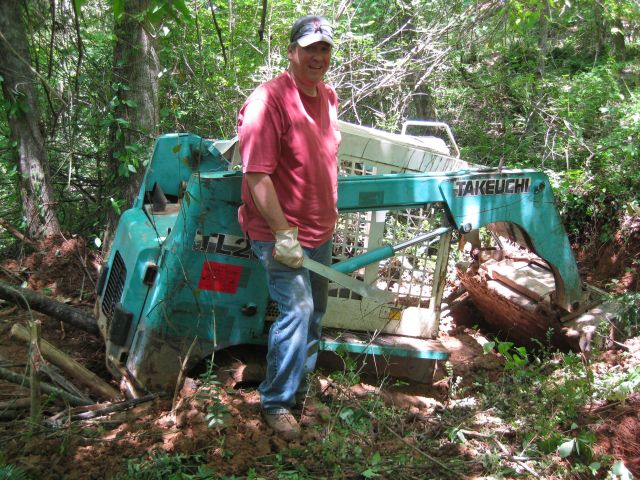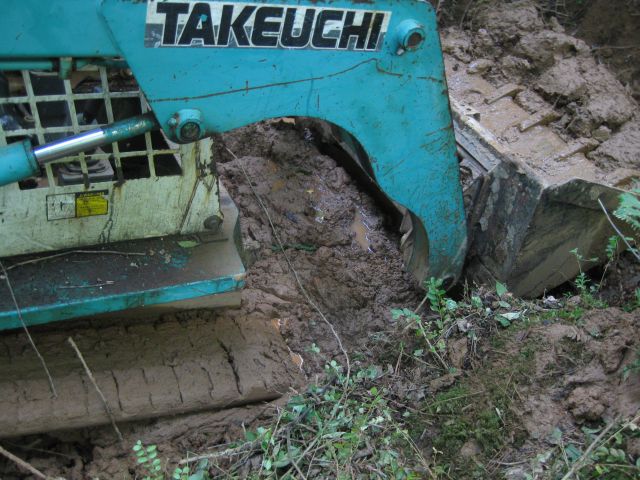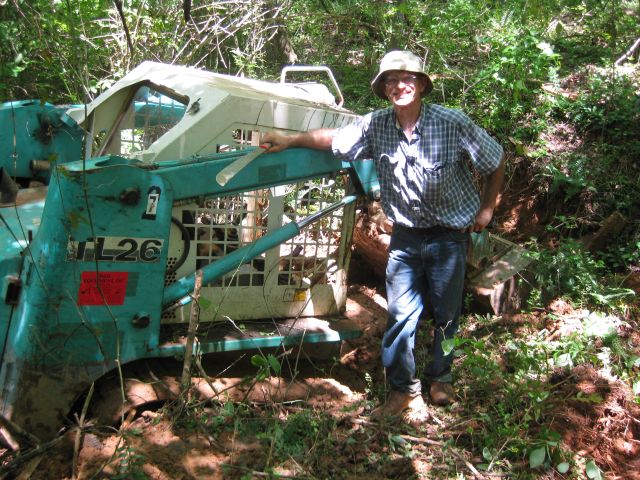Luck shouldn’t factor into daily events – maybe it has a role in investing, or coincidental meetings, but surely not when it comes to my tracked Takeuchi bobcat. The way I am feeling right now is lucky and this is probably because I acted carelessly and was able to extricate myself from a sticky jam, actually muddy patch, without much loss.
I mentioned previously a trail I cut through the woods which ran close to a spring. The spring fills a small pool from which it saunters down the hill, mostly unseen, below the surface of a dry stream bed. My thought was to cut an access path from the trail to the spring and then enlarge the pool. Because this is rough terrain my friend Mike volunteered to be on hand for the unforeseen. Cutting the access path was relatively straightforward – we agreed on the route, then highlighted the route with yellow rope, then me with the bobcat and Mike with the machete, cut the path to the spring.
How to deepen the pool. The lowest side of the pool was on the northwest but it was barred by briar necklaces. So I initially approached with the bobcat from the higher west bank and quickly realized the incline was too steep. So I backed out the bobcat and we hacked an approach from the northwest which shouldered between two large trees. The bobcat loader made quick work of thick roots and, because I was tired from my previous attempt and lack of sleep the previous evening (to sleep at 1am and up at 5am to drop a relative at the airport), I was impatient and did not widen the new ramp or cut it for a more gentle approach angle. I headed down the ramp in the bobcat, loaded the bucket with mud backed out and dumped the contents. That was easy, so without pause I went in again, deeper. As I backed out the bobcat’s tracks began to spin.
I have learned a lot the past 24 hours. Tracks are great and provide much, much more traction on wet soil than wheels. But, if the front of the bobcat is in water and you are backing out, the mud covered track at the front moves to the rear and slathers the dry soil under the rear tracks with water and mud. The first, primeval instinct is panic, I gotta get out, so you increase the throttle and more mud and water are rapidly transferred to the back and the front of the bobcat settles deeper into the mud because it is digging a hole by the tracks scooping up the mud and water in the front, and transferring it to the rear. I plunged the loader edge vertically into the mud and tried to use the leverage of the loader to push the bobcat backward up the ramp. To no avail.

So I cut the engine and together with Mike we strategized. When a vehicle is trapped in soft sand you place sticks and branches and rough material behind or in front of the engine driven wheels for the treads to grip and, with some luck (again the “luck” word) you can get out. We cut lengths of 4″ to 6″ diameter trunks (lots of trees around) and jammed these under the tracks – this was possible because using the loader I was able to move the bobcat forward onto its front edge and expose the rear tracks. Then with full throttle and using the loader for leverage I powered the bobcat backwards – and barely moved.
I suggested to Mike that rather than place the trunks parallel and under the tracks we should place them at right angles to the tracks. A lot of work and full bore throttle and – no progress.

We thought the rear of the bobcat was catching the ground and so with long handled shovels we dug out the dirt and, with a lot of throttle, gained a few inches to freedom. At this point, with 4 hours invested to little avail, Mike had to leave and kindly agreed to return the next day and his parting words were “you are tired, leave it for tonight, you can get injured.” Which is good advice when you are deep in the woods with no one around.
Getting stuck in the mud, especially with a tracked vehicle, which should not get stuck anywhere, is an insult to ones sense of independence, self reliance, and ego. Needless to say, I spent another hour digging, investigating and throttling and concluded a) remnants of the roots of the biggest tree were snagging the bobcat (revenge of the tree whose roots I had savaged); b) pushing wood under the tracks was a bad idea – the wood became slippery from the mud and water and because it did not span the width of the tracks, a good part of the gripping surface of the tracks was not getting traction; and c) the spring, which I had thought was a dribbler seemed more of a gusher and the water from the spring was transforming the area into a mud bath.

After a really good night’s sleep and early next morning I was back at the muddy site – my hope was to single handed retrieve the situation and save Mike a trip. I replaced the new chain on my chainsaw with an older chain and cut through some of the blocking roots – their diameter was 4″ to 6″ and I decided the old chain would be temporarily sacrificed cutting roots surrounded by soil and pebbles (until I could re-sharpen it). This helped and I got the bobcat back about 6″. I then decided the rising water was a problem and with the machete cleared a path down the dry stream bed and then with shovel and pick axe dug a 40ft trench in the stream bed. The bed appeared dry on the top but the holes dug by the shovel quickly revealed the water running just below the surface. This helped to remove the water which had been building up around the bobcat.
But it still wasn’t moving. I was convinced that the bobcat was snagging on concealed obstacles and, as I dug deeper around the rear of the bobcat and its tracks, these came to light. By this time Mike had arrived and together, with an array of tools from long handled edgers, mattock, grubbing tools, hand saws and the rapidly blunting chain saw we cleared a path to the rear. With the benefit of a night’s sleep we agreed that the tracks would grip better if they were not covered with mud and that spinning the tracks quickly in frustration just dug the machine in deeper. So the new modus operandi after clearing obstacles, including belatedly all the wood we had the previous day shoved under the tracks, was to use our gloved hands to pull the mud out of the exposed treads in the track. Then, in a frequently repeated sequence, with hopes high, I would fire up the bobcat, apply throttle and slowly power the bobcat rearwards and gain a few inches more to freedom. Unlike the previous day we were thinking rather than just acting and we were following a procedure that appeared to have traction. It was surprising how many times we were sure it would get out and it didn’t. But, eventually, with Mike yelling encouragement I escaped the clutches of the mud and got to level ground.
Was it luck? Probably not, but an education into new techniques, the importance of thinking it out and a good night’s sleep.
